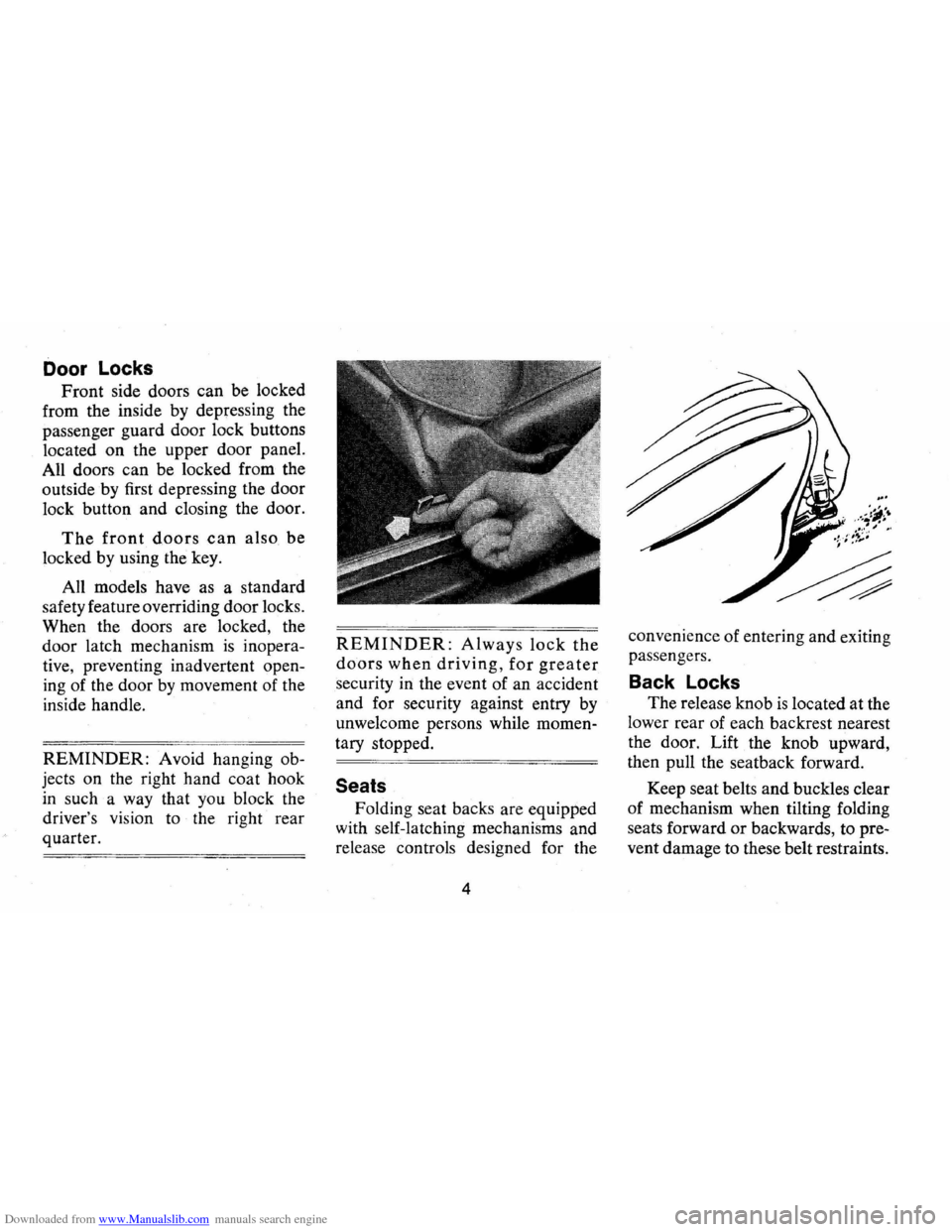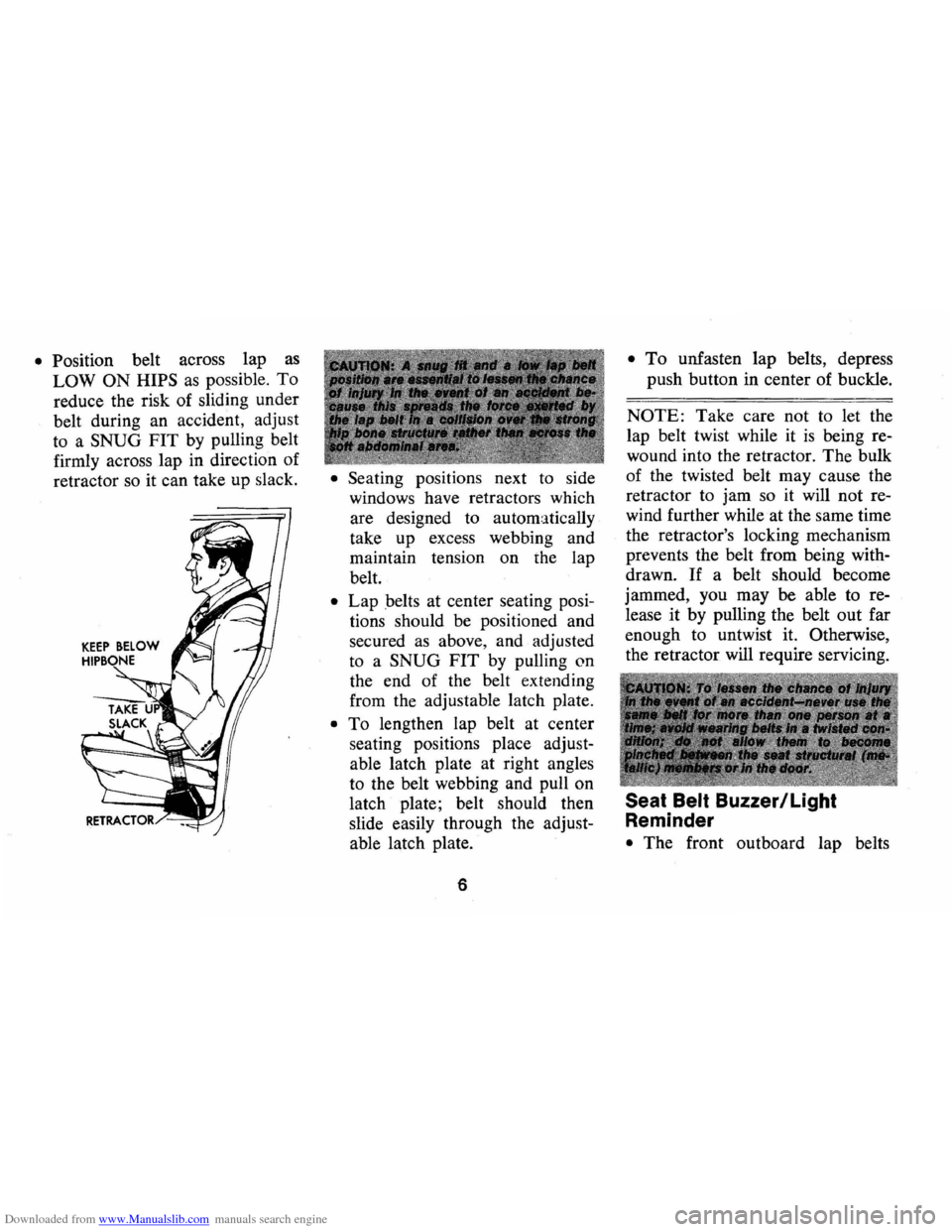ECU CHEVROLET CAMARO 1973 2.G Owners Manual
[x] Cancel search | Manufacturer: CHEVROLET, Model Year: 1973, Model line: CAMARO, Model: CHEVROLET CAMARO 1973 2.GPages: 84, PDF Size: 32.64 MB
Page 7 of 84

Downloaded from www.Manualslib.com manuals search engine Door Locks
Front side doors can be locked
from the inside by depressing the
passenger guard door lock buttons
located
on the upper door panel.
All doors can be locked from the
outside by first depressing the door
lock button and closing the door.
The front doors can also be
locked by using the key.
All models have as a standard
safety feature overriding door locks.
When the doors are locked , the
door latch mechanism
is inopera
tive , preventing inadvertent open
ing of the door by movement of the
inside handle.
REMINDER: Avoid hanging ob
jects on the right hand coat hook
in such a way that you block the
driver 's
vis ion to the right rear
quarter.
REMINDER: Always lock the
doors when driving, for greater
security in the event of an accident
and for security against entry by
unwelcome persons while momen
tary stopped.
Seats
Folding seat backs are equipped
with self-latching mechanisms and
release controls designed for the
4 convenience
of entering and exiting
passengers .
Back Locks
The release knob is located at the
lower rear of each backrest nearest
the door. Lift the knob upward,
then pull the seatback forward.
Keep seat belts and buckles clear
of mechanism when tilting folding
seats forward
or backwards, to pre
vent damage to these belt restraints.
Page 8 of 84

Downloaded from www.Manualslib.com manuals search engine Manually Operated
Front Seats
The front seats may be adjusted
to suit an individual's preference.
Simply release the seat lock mech
anism located at the front of the
seat.
Once released, exert slight
body pressure in the direction de
sired. Release the lever
so the seat
will lock in the desired position.
Inside Rearview Mirrors
Switch mirror to night position
to reduce glare from following headlights.
To raise or lower,
grasp mirror and exert sufficient
pressure
by pushing or pulling to
move mirror up
or down.
Occupant Restraint Belts
Lap and shoulder belts provide
added security and comfort for you
and your passengers.
Proper use
and care of these belts will assure
continuance of this security.
Lap Belts
• Adjust front seat to satisfaction
of driver and sit erect and
well
back in seat.
5
• In a single motion, pull webbing
across lap far enough to permit
inserting metal latch plate end
of lap belt into the buckle, until
a snap
is heard. If not pulled
out far enough to reach, let belt
rewind into the retractor to re
lease lock mechanism, so belt
can be pulled out to the proper
length.
Page 9 of 84

Downloaded from www.Manualslib.com manuals search engine • Position belt across lap as
LOW ON HIPS as possible. To
reduce the risk of sliding under
belt during an accident, adjust
to a
SNUG FIT by pulling belt
firmly across lap in direction
of
retractor so it can take up slack. • Seating posItIOns next to side
windows have retractors which
are designed to automatically
take up excess webbing and
maintain tension on the lap
belt.
• Lap belts at center seating posi
tions should be positioned and
secured as above, and adjusted
to a
SNUG FIT by pulling on
the end of the belt extending
from the adjustable latch plate.
• To lengthen lap belt at center
seating positions place adjust
able latch plate at right angles
to the belt webbing and pull on
latch plate; belt should then
slide easily through the adjust
able latch plate.
6
• To unfasten lap belts, depress
push button
in center of buckle.
NOTE: Take care not to let the
lap belt twist while it
is being re
wound into the retractor.
The bulk
of the twisted belt may cause the
retractor to jam so it will not re
wind further while at the same time
the retractor's locking mechanism
prevents the belt from being with
drawn.
If a belt should become
jammed, you may be able to re
lease
it by pulling the belt out far
enough to untwist it. Otherwise,
the retractor will require servicing.
Seat Belt Buzzer/Light
Reminder
• The front outboard lap belts
Page 12 of 84

Downloaded from www.Manualslib.com manuals search engine • Keep sharp edges and damaging
objects away from belts.
• Replace belts if cut, weakened,
frayed, or subjected to collision
loads.
• Check that anchor mounting
bolts are tight.
• Have questionable parts re
placed.
• Keep seat belts clean and dry.
• Clean only with mild soap solu
tion and lukewarm water.
• Do not bleach or dye belts since
this may severely weaken belts.
Child Restraint
Children in automobiles · should
be restrained to lessen the risk of
injury in accidents, sudden stops
or other hazardous situations.
General Motors dealers offer re
straint systems designed specific
ally for use with infants. In using
any infant or child restraint
sys
tem, read and comply with all in- stallation
and usage instructions.
All unused seat belts near the
child should be stowed properly to
help prevent them from striking
him in the event of an accident.
Lap belts and shoulder belts with
out storage provisions should have
buckles latched and belts adjusted
to remove slack.
Cars Not Equipped With
Special Child Restraints
If a child is traveling in a vehi
cle not equipped with a General
Motors
inf~mt restraint or other
safe infant or child restraint
sys
tem, . the following precautions
should be taken:
1. Infants unable to sit up by
themselves should be restrained
by placing them in a covered,
padded bassinet which
is placed
crossways in the vehicle (width
wise) on the rear seat. The bas
sinet should be securely re
strained with the regular vehi-
9
cle seat belts. An alternate me
thod
is to position the bassinet
so that it rests against the back
of the front seat, again cross
ways in the vehicle.
2. Children able to sit up by them
selves should be placed on a
seat and lap belted, preferably
in the rear seat. Never allow a
child to stand or kneel on any
seat.
If the child cannot see out
the car windows he should sit
on a firm cushion with the reg
ular lap belt restraining him at
the hips. The cushion should be
as firm as practical and just
high enough to enable the child
to look horizontally out of the
car windows. The use of the
cushion should be discontinued
as soon as the child is old
enough to see out of the car
windows without it.
3. General Motors recommends
that children be restrained